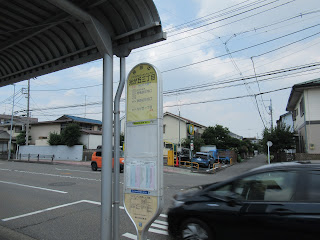This year, actually, city swallows chose a field of reeds near JR Kawasaki Station 川崎駅. Oh yes, that terminal station for industrial Kawasaki City 川崎市. The reeds are on Tokyo-side of the bank of Tama River, 多摩川 but watching birds from Tokyo side is blocked by the other vegetation like trees and plume grasses that love drier soil. Kawasaki-side is wide open and provides easier view for birdwatching in the reeds field spreading along the waterfront. That evening, we met at the north exit of Minatomachi Station 港町駅, the next stop from Kawasaki Station for Keikyu Daishi Line 京急大師線. The area was recently undergone a large “gentrification” development. Posh tower apartments are dominating the exit area of the station. Childcare facilities and indoor golf training gym are claiming their value with stylistic billboards. Very apt for city-slicker swallows waiting for an international flight, I thought.
 |
| Minatomachi Station |
 |
| The tower apartments |
Already in front of the station we could feel a wind of (relatively) cool evening air from Tama River and Tokyo Bay. We walk a couple of minutes along a boulevard between the modern skyscraper apartments, and the south bank of the River was just before us. Joggers and strollers enjoyed the evening after boiling heatwave of Tokyo. We took few steps up to the bank. The people of Wild Bird Society of Japan (WBSJ) are waiting for us with powerful monoculars focusing on the reed field on the Tokyo-side. At 18:15, the sun as not yet set, but the sky was definitely heading for night. The downstream of Tama River pours into the Bay at the right next to the Haneda Airport 羽田空港. It was busy evening and lots of airplanes coming and going over there. Huge bright lights of airplanes competing with the setting sun. The machine looked so near our position. I felt a wonder wild swallows make this scenery their home.
 |
| People from WBSJ were waiting for us. |
 |
| Lots of egrets were also there. This is Medium Egrets. |
 |
| And airplanes. |
We waited for several minutes. Somebody among us found tiny dots flying around above an apartment roof on Tokyo-side. “Swallows!” Murmur in a hashed voice spread among us. Just like us humans, evening swallows were heading home from their daily activities. The way they came home was also like us; individually. The birds were not a flock, but flied solo and looked like saying good evening as they encountered their neighbor in their bed town. In general, they flied around for a while before descending on the leaves to sleep. Many glided very near to the surface of the River where they could hunt bags for an evening meal. It’s like we dropping in supermarket for prep of evening meals. Several of them looked playing around with another swallows. Is it like enjoying happy hour in Izakaya?
 |
| The
first sighting was around here. I couldn’t take a photo of them! |
 |
| I thought
I photographed the moment a swallow flying over the water surface … |
One by one they went “reed” home and made themselves comfortable to sleep. Some were staying “Tama River Izakaya” until the last (oh, yeah, literally) minutes before sunset. But in the end, they were in “bed” at the tip of reed leaves. It seemed to me they did not mind their neighbor swallow were there VERY near to their bed. … Like school dormitory, or, similar to us in apartment blocks with the neighbor’s door just next to us …?
 |
| In
this photo, there are so many swallows. Almost all the blackish dots at the end of reed are swallows ready to sleep. |
At the sunset the event was over. WBSJ lent us very powerful binoculars to enjoy the birdwatching. They also explained us the lifecycle of swallows and shared their accumulated experience to watch swallows “Bedtime” event. They also gave us tips to take nice photos. I understood why this event was SO popular, with uber-competitive entries. Every year they start lottery entry for nation-wide events early July (; their HP is here). If you’re interested in nature watching, please try. It’s really worth experiencing it. Besides, having birdwatching on a cooler bank of Tama River after sweltering business day in Tokyo is really GOOD.
| The binocular I borrowed. |
 |
| People from WBSJ explains. |
Wild Bird Society of Japan











































